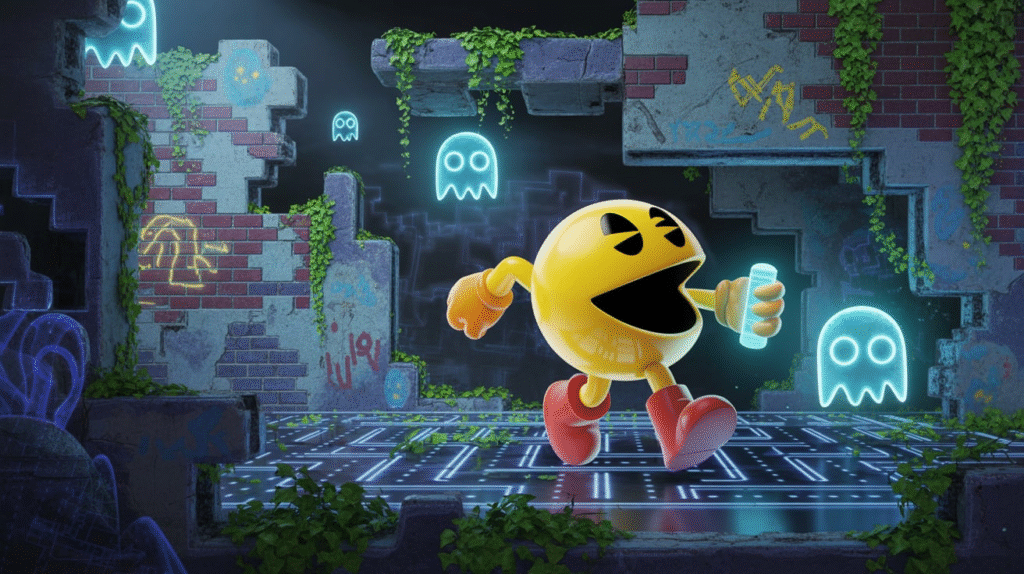Pac-Man isn’t just munching pellets anymore he’s breaking barriers, solving puzzles, and descending into darkness. Pac-Man Reloaded is a bold reimagining of the arcade icon. Forget the cheery chimes and pixel ghosts. Now think dim corridors, hidden chambers, and a maze that feels more alive than ever. Inspired by the Metroidvania genre, this reboot is gritty, complex, and emotionally charged.
Linkhouse
While staying true to its roots, Pac-Man Reloaded incorporates deep exploration mechanics, unlockable abilities, and narrative elements you’d never expect from the yellow hero. In this blog, we break down how this transformation happened, why it’s resonating with both retro gamers and indie fans, and how game development companies are taking notes.
From Arcade to Apocalypse
The original Pac-Man thrived in its simplicity. Eat pellets, dodge ghosts, repeat. But Pac-Man Reloaded tosses that formula into a blender of modern design philosophy.
Now set in a post-apocalyptic cyber-labyrinth, this version of the game introduces a rich backstory. Pac-Man isn’t just a consumer; he’s a rebel program fighting to restore balance inside a corrupted machine world. Levels are no longer loops; they’re sprawling, interconnected environments brimming with secrets.
This shift toward a Metroidvania structure where exploration, upgrades, and backtracking are key completely changes the gameplay. And it’s something no one saw coming from the king of arcades.
Metroidvania DNA
So what makes Pac-Man Reloaded a Metroidvania? First off, it’s the structure. Instead of short, linear levels, you’re placed in one massive, intricate map. Early in the game, doors, walls, and even ghost types block you from progressing—until you earn new abilities.
Think wall-jumps, phasing through ghost energy, or devouring corrupted data to unlock hidden corridors. Each skill not only expands your combat abilities but also your navigation.
This clever layering of movement and discovery taps directly into what makes Metroidvania games so addictive. For fans of Hollow Knight or Axiom Verge, this Pac-Man feels like a surprising but welcome cousin.
Gritty Visuals, Cinematic Sound
Classic Pac-Man was bright, bubbly, and kid-friendly. Pac-Man Reloaded takes a hard left turn visually. Imagine dark neon mazes lit only by glitchy code flickers. The ghosts look like monstrous programs gone haywire, with glowing eyes and glitch trails.
Even Pac-Man himself looks tougher more polygonal, with a subtle glow and battle scars. The sound design adds to the unease. Low synth hums, electronic groans, and pulsing ambient music create a surprisingly tense atmosphere.
A good game development company knows the power of aesthetics, and Pac-Man Reloaded is a masterclass in reinvention through design.
Read Also >>> Best Gaming Guide by MyGameRank for Every Gamer
Gameplay Mechanics
While the foundation remains classic chomp to survive the game introduces fresh mechanics. Pac-Man now has an energy bar. When filled, he can temporarily shift into “Overdrive Mode,” allowing him to phase through walls or slow down time.
Combat isn’t passive anymore. You’ll occasionally face corrupted ghost bosses, each with distinct attack patterns, weak points, and arenas. It’s no longer just about avoiding—sometimes it’s about confronting.
This is where modern mechanics meet retro charm. The addition of tactical gameplay brings a new layer of strategy that demands skill and patience.
Narrative Layers
For the first time, Pac-Man has a story—and it’s not a cheesy afterthought. Through data fragments, corrupted files, and mysterious NPCs, a deeper narrative unfolds. We learn of a broken system, rogue programs, and the origins of the ghosts who were once guardians turned corrupted.
Pac-Man’s journey mirrors a resistance movement inside a digital dystopia. The writing is cryptic but compelling, leaving players curious about the deeper truths.
Many players are surprised by how emotionally engaging the game becomes. The use of storytelling in this way shows how modern narrative design can evolve even the most straightforward characters something top game development companies are actively applying across genres.
Skill Trees and Upgrades
One of the most exciting new elements in Pac-Man Reloaded is the upgrade system. Players can now tailor their abilities through a branching skill tree. Will you invest in stealth, speed, or raw power?
Each path not only affects how you play but also which areas you can explore. For instance, choosing the “Phantom Dash” upgrade opens up hidden corridors invisible to standard players. This encourages multiple playthroughs and experimentation.
For a character that once had a single “power pellet” upgrade, this depth is revolutionary. It also reflects how player agency has become a core pillar for any modern game development company.
Fans React
You’d expect die-hard fans to push back—but surprisingly, many are embracing this darker, deeper Pac-Man. On gaming forums and subreddits, fans are praising the bold risk. “It’s like Dead Cells and Tron had a baby,” wrote one user. Another noted, “I never thought I’d cry over Pac-Man lore. But here we are.”
Of course, purists miss the simplicity. But most agree this isn’t a replacement—it’s a new timeline. A mature spin-off that gives the yellow ball a new lease on life.
That reception proves the value of innovation. For developers and any aspiring game development company, it’s a lesson in respecting tradition while daring to push boundaries.
What Game Developers Can Learn from Pac-Man Reloaded
The success of Pac-Man Reloaded holds key takeaways for any game development company looking to revive or expand classic IPs:
- Don’t just remaster rebuild.
Simply updating graphics isn’t enough. A reimagined core can breathe new life into old franchises. - Blend genres boldly.
Adding Metroidvania elements transformed gameplay in surprising ways that felt fresh but familiar. - Give players choices.
Whether through narrative decisions or ability trees, modern gamers crave agency and replayability. - Invest in world-building.
Even a minimalist hero like Pac-Man can become part of a vast, emotional universe.
These principles, when combined, create not just a game but a memorable experience.
Could Other Arcade Legends Get the Metroidvania Treatment?
If Pac-Man can go gritty and emotional, why not others? Imagine a Donkey Kong reimagined as a survival platformer where Mario is the real villain. Or Galaga as a rogue-like space opera with procedurally generated enemy factions.
The possibilities are endless. A forward-thinking game development company should be asking, “What classic could we transform next?”
By blending nostalgia with modern depth, developers can tap into a dual audience—retro fans and new-gen gamers alike. In a sea of sequels, remasters, and clones, Pac-Man Reloaded stands out by doing something rare: it evolves.
Conclusion
Pac-Man Reloaded isn’t just a reboot. It’s a renaissance. It proves that even the simplest game mechanics, when treated with respect and innovation, can become something emotionally and technically profound.
This dark, layered, and surprisingly moving version of Pac-Man isn’t just for hardcore gamers it’s for anyone who ever believed a yellow circle could be more than a mascot. As the maze expands and players dive deeper, one thing becomes clear: Pac-Man is far from done. And the future of retro-inspired innovation looks brighter than ever—even if the corridors stay dark.
Read More: Call of Duty Black Ops 7







